Fatigue Fracture Mechanism of a Nickel-Based Single Crystal Superalloy with Partially Recrystallized Grains at 550 °C by In Situ SEM Studies
Abstract
:1. Introduction
2. Material and Experimental
3. In Situ Observation Results
3.1. Fatigue Crack Initiation Mechanism
3.2. Fatigue Crack Propagation Behavior
4. Discussion
4.1. Effect of Temperature
4.2. Microstructurally Small Crack Behavior
5. Conclusions
- (1)
- Multiple crack initiation was observed at the recrystallized grain boundaries, either by intergranular cracking of grain boundaries, or by the fracture of carbides at the grain boundaries.
- (2)
- The operated slip systems for both the nickel-based single crystal superalloy and the recrystallized grains were identified to be octahedral slips, by analysis of surface slip trace and crystallographic configuration.
- (3)
- The recrystallized nickel-based single crystal superalloy showed distinct fatigue fracture mechanisms at 550 °C. Crystallographic slip deformation is responsible for all fatigue cracks in the present study. The intergranular cracking of the recrystallized grain boundary was due to the impingement of intensive slip bands against the grain boundary. The subsequent fatigue crack propagation was dominated by transgranular cracking manner. At high temperature, commonly reported intergranular cracking would be expected.
- (4)
- Fatigue crack propagation exhibited microstructural small crack behavior. Local microstructural inhomogeneities, such as recrystallized grain boundaries or interfaces, were found to expressly alter the propagation path as well as the crack growth rate. Besides, the competition between different slip systems and the crack coalescence mechanisms were another two important factors responsible for the evident fluctuation in fatigue crack growth rate curve.
Author Contributions
Funding
Acknowledgments
Conflicts of Interest
References
- Joyce, M.R.; Wu, X.; Reed, P.A.S. The effect of environment and orientation on fatigue crack growth behaviour of CMSX-4 nickel base single crystal at 650 °C. Mater. Lett. 2004, 58, 99–103. [Google Scholar] [CrossRef]
- Ma, X.; Shi, H.J.; Gu, J.L.; Yang, Z.; Chen, G.F.; Luesebrink, O.; Harders, H. Influence of surface recrystallization on the low cycle fatigue behavior of a single crystal superalloy. Fatigue Fract. Eng. Mater. 2015, 38, 340–351. [Google Scholar] [CrossRef]
- He, Y.H.; Hou, X.Q.; Tao, C.H.; Han, F.K. Recrystallization and fatigue fracture of single crystal turbine blades. Eng. Fail. Anal. 2011, 18, 944–949. [Google Scholar] [CrossRef]
- Li, Z.; Xu, Q.; Liu, B. Experimental investigation on recrystallization mechanism of a Ni-base single crystal superalloy. J. Alloy. Compd. 2016, 672, 457–469. [Google Scholar] [CrossRef]
- Meng, J.; Jin, T.; Sun, X.; Hu, Z. Effect of surface recrystallization on the creep rupture properties of a nickel-base single crystal superalloy. Mater. Sci. Eng. A 2010, 527, 6119–6122. [Google Scholar] [CrossRef]
- Xie, G.; Lou, L.H. Influence of the characteristic of recrystallization grain boundary on the formation of creep cracks in a directionally solidified Ni-base superalloy. Mater. Sci. Eng. A 2012, 532, 579–584. [Google Scholar] [CrossRef]
- Zhang, B.; Lu, X.; Liu, D.L.; Tao, C.H. Influence of recrystallization on high-temperature stress rupture property and fracture behavior of single crystal superalloy. Mater. Sci. Eng. A 2012, 551, 149–153. [Google Scholar] [CrossRef]
- Bürgel, R.; Portella, P.D.; Preuhs, J. Recrystallization in Single Crystals of Nickel Base Superalloys. In Superalloys 2000; Pollock, T.M., Kissinger, R.D., Bowman, R.R., Eds.; TMS: Warrendale, PA, USA, 2000; pp. 229–238. [Google Scholar]
- Ma, X.F.; Shi, H.J.; Gu, J.L. In-situ scanning electron microscopy studies of small fatigue crack growth in recrystallized layer of a directionally solidified superalloy. Mater. Lett. 2010, 64, 2080–2083. [Google Scholar] [CrossRef]
- Shi, H.J.; Zhang, H.F.; Wu, Y.Q. Effect of recrystallization on low-cycle fatigue behavior of DZ4 directionally-solidified superalloy. Key Eng. Mater. 2006, 306–308, 175–180. [Google Scholar] [CrossRef]
- Zhao, Y.; Wang, L.; Li, H.Y.; Yu, T.; Liu, Y. Effects of recrystallization on the low cycle fatigue behavior of directionally solidified superalloy DZ40M. Rare Met. 2008, 27, 425–428. [Google Scholar] [CrossRef]
- Jia, B.; Li, C.G.; Li, H.Y. Influence of Recrystallization Layer at Surface on Fatigue Behaviors of Directionally Solidified DZ4 Superalloy. Mater. Eng. 2008, 6, 64–71. [Google Scholar]
- Ma, X.; Shi, H.J. In situ SEM studies of the low cycle fatigue behavior of DZ4 superalloy at elevated temperature: Effect of partial recrystallization. Int. J. Fatigue 2014, 61, 255–263. [Google Scholar] [CrossRef]
- Rabbolini, S.; Luccarelli, P.G.; Beretta, S.; Foletti, S.; Sehitoglu, H. Near-tip closure and cyclic plasticity in Ni-based single crystals. Int. J. Fatigue 2016, 89, 53–65. [Google Scholar] [CrossRef]
- Rabbolini, S.; Pataky, G.J.; Sehitoglu, H.; Beretta, S. Fatigue crack growth in Haynes 230 single crystals: An analysis with digital image correlation. Fatigue Fract. Eng. Mater. 2015, 38, 583–596. [Google Scholar] [CrossRef]
- Luccarelli, P.G.; Pataky, G.J.; Sehitoglu, H.; Foletti, S. Finite element simulation of single crystal and polycrystalline Haynes 230 specimens. Int. J. Solids Struct. 2017, 115, 270–278. [Google Scholar] [CrossRef]
- Ma, X.F.; Shi, H.J.; Gu, J.L.; Wang, Z.X.; Harders, H.; Malow, T. Temperature effect on low-cycle fatigue behavior of nickel-based single crystalline superalloy. Acta Mech. Solida Sin. 2008, 21, 289–297. [Google Scholar] [CrossRef]
- Zhang, Z.F.; Wang, Z.G. Dependence of intergranular fatigue cracking on the interactions of persistent slip bands with grain boundaries. Acta Mater. 2003, 51, 347–364. [Google Scholar] [CrossRef]
- Ma, X.; Wei, D.; Han, Q.; Rui, S. Parametric study of cyclic plasticity behavior in a directionally solidified superalloy with partial recrystallization by crystal plasticity finite element simulation. J. Mater. Eng. Perform. 2019. [Google Scholar] [CrossRef]
- Wang, X.S.; Fan, J.H. An evaluation on the growth rate of small fatigue cracks in cast AM50 magnesium alloy at different temperatures in vacuum conditions. Int. J. Fatigue 2006, 28, 79–86. [Google Scholar] [CrossRef]
- Paris, P.; Erdogan, F. A critical analysis of crack propagation laws. J. Basic Eng. Dec. 1963, 85, 528–533. [Google Scholar] [CrossRef]
- Telesman, J.; Ghosn, L.J. Fatigue crack growth behavior of PWA 1484 single crystal superalloy at elevated temperatures. J. Eng. Gas Turbines Power 1996, 118, 399–405. [Google Scholar] [CrossRef]
- Henderson, M.B.; Martin, J.W. The influence of crystal orientation on the high temperature fatigue crack growth of a Ni-based single crystal superalloy. Acta Mater. 1996, 44, 111–126. [Google Scholar] [CrossRef]
- Suresh, S. Fatigue of Materials, 2nd ed.; Cambridge University Press: New York, NY, USA, 1998. [Google Scholar]
- Ma, X.; Jiang, J.S.; Zhang, W.J.; Shi, H.J.; Gu, J.L. Effect of Local Recrystallized Grains on the Low Cycle Fatigue Behavior of a Nickel-Based Single Crystal Superalloy. Crystals 2019, 9, 312. [Google Scholar] [CrossRef] [Green Version]

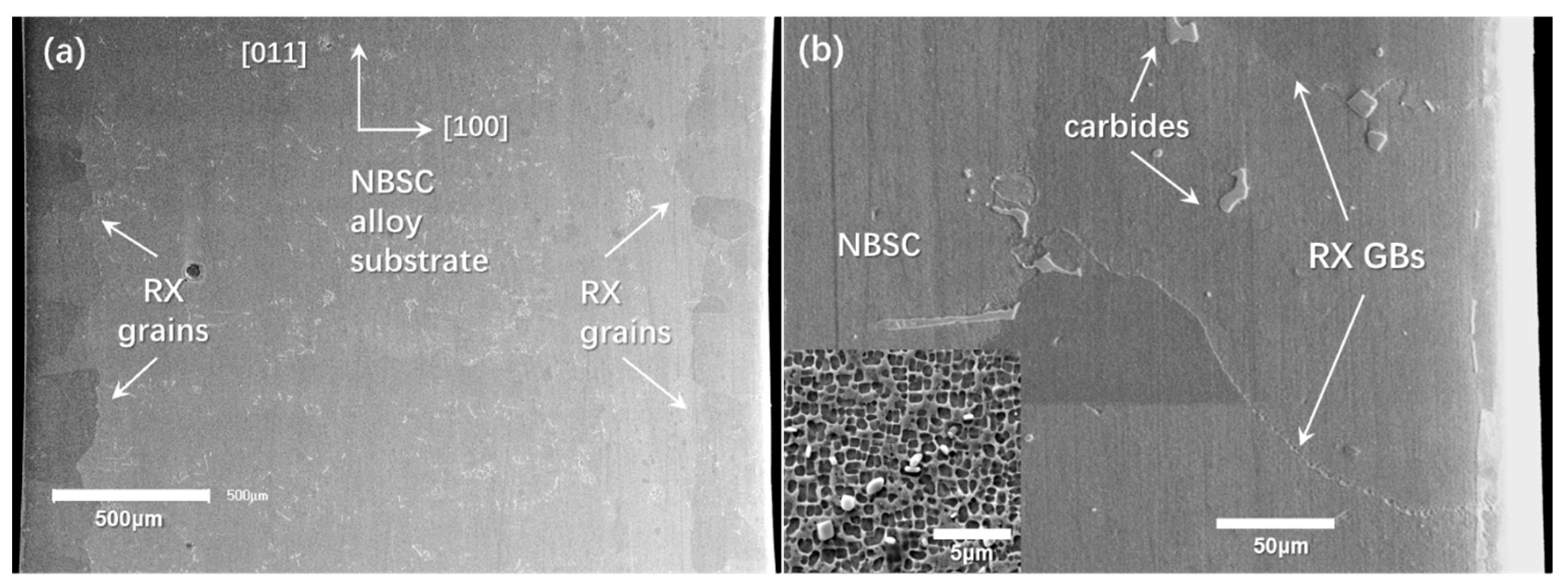
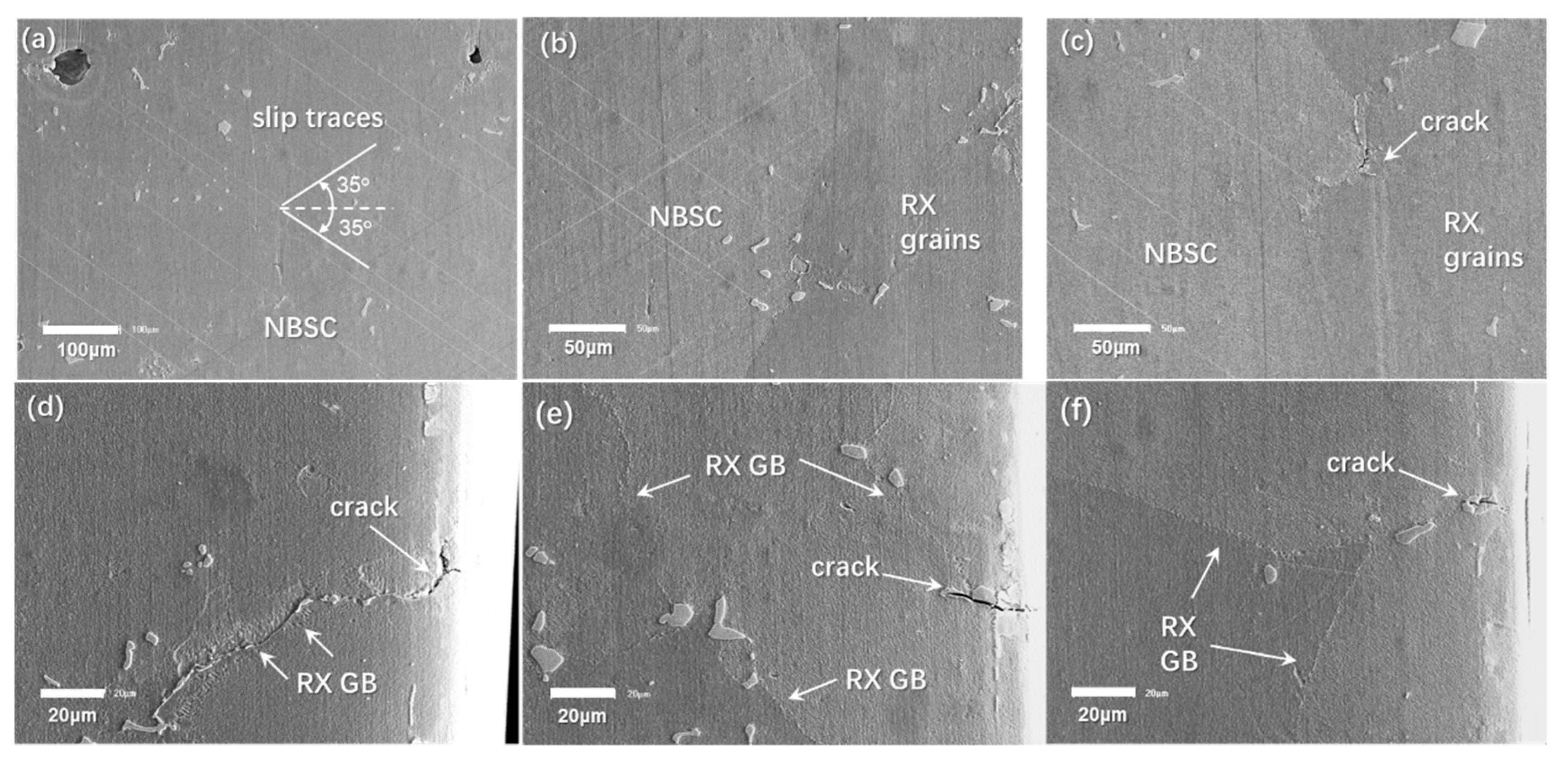
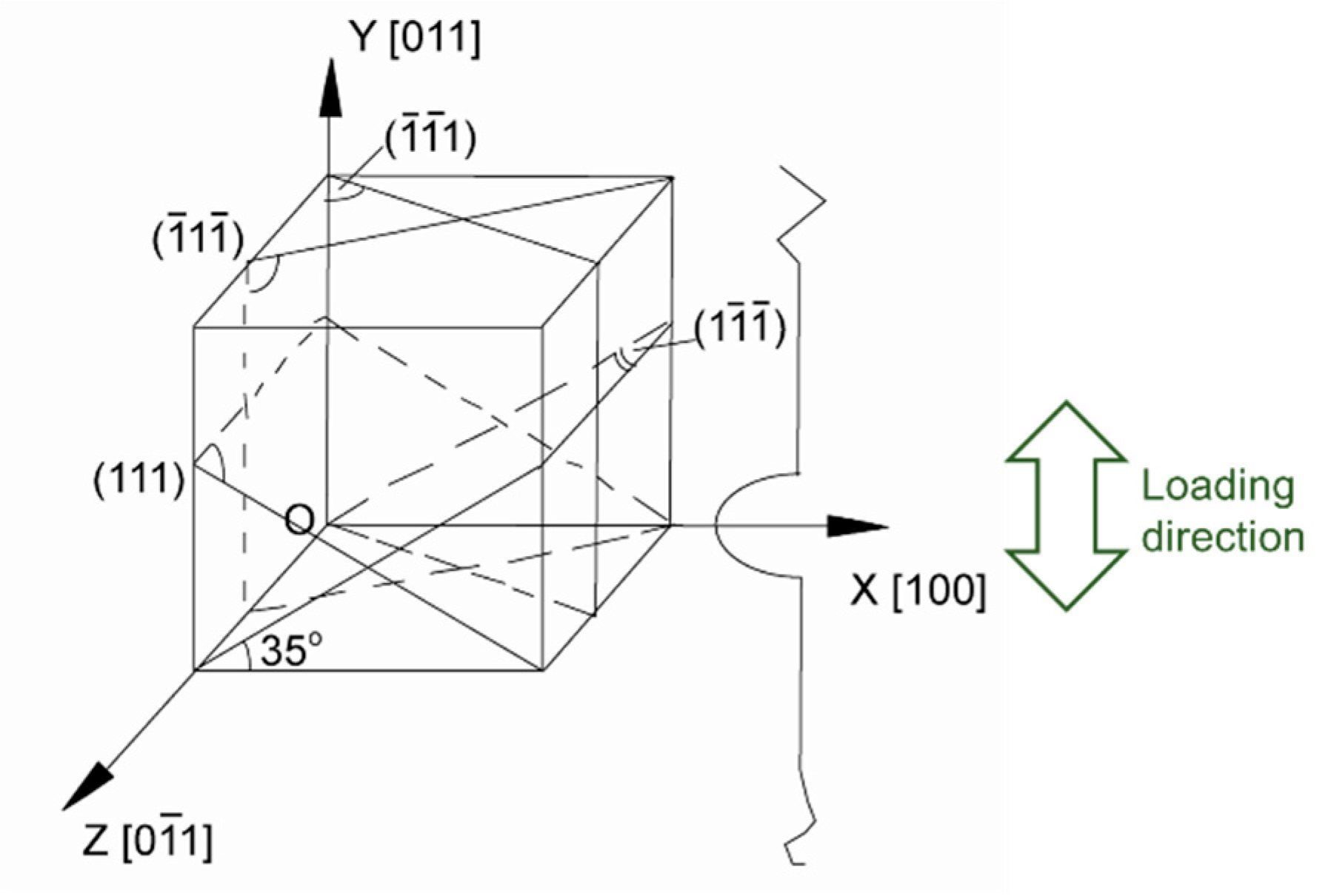

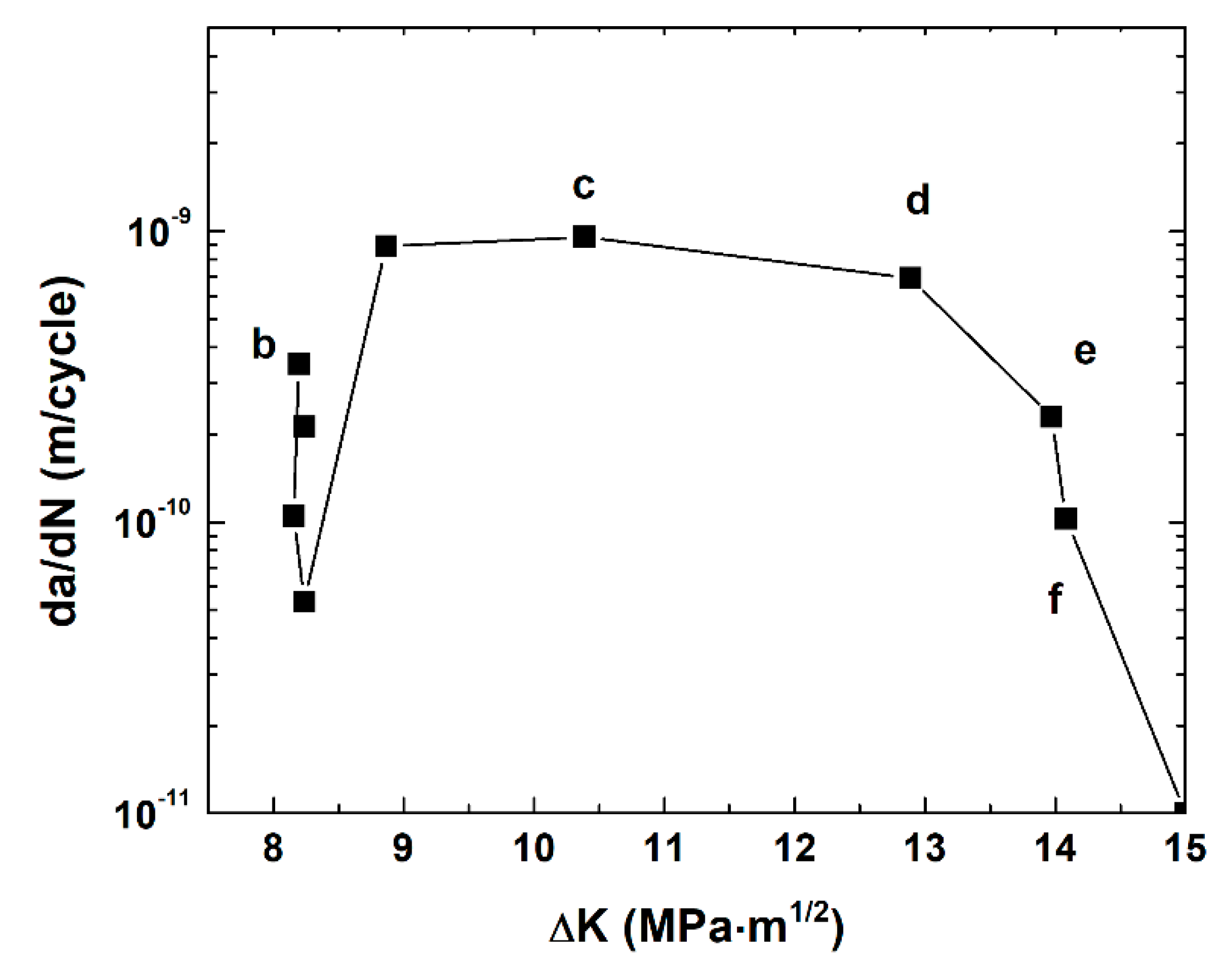

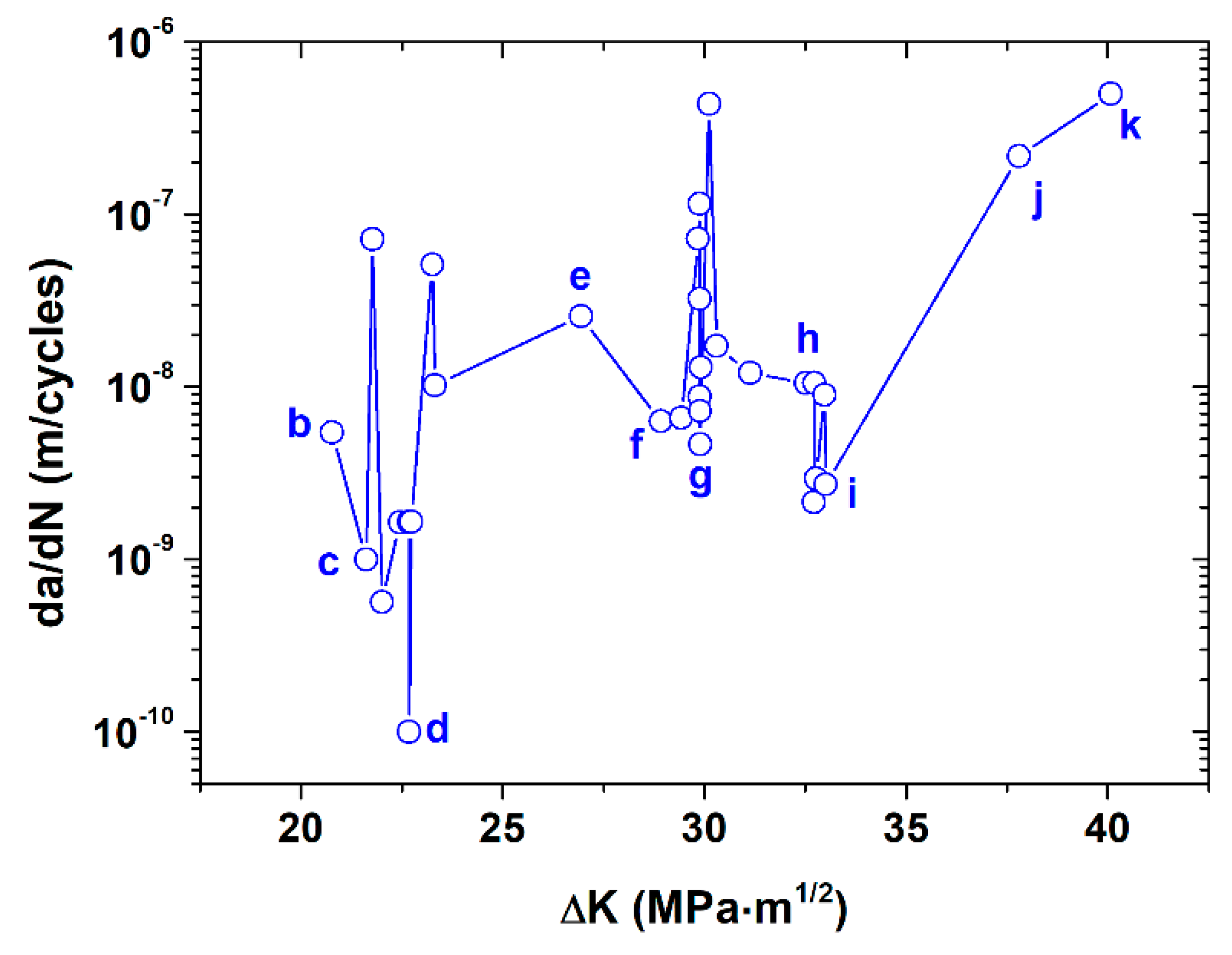


© 2020 by the authors. Licensee MDPI, Basel, Switzerland. This article is an open access article distributed under the terms and conditions of the Creative Commons Attribution (CC BY) license (http://creativecommons.org/licenses/by/4.0/).
Share and Cite
Yang, H.; Jiang, J.; Wang, Z.; Ma, X.; Tu, J.; Shi, H.-j.; Zhai, H.; Zhang, W. Fatigue Fracture Mechanism of a Nickel-Based Single Crystal Superalloy with Partially Recrystallized Grains at 550 °C by In Situ SEM Studies. Metals 2020, 10, 1007. https://doi.org/10.3390/met10081007
Yang H, Jiang J, Wang Z, Ma X, Tu J, Shi H-j, Zhai H, Zhang W. Fatigue Fracture Mechanism of a Nickel-Based Single Crystal Superalloy with Partially Recrystallized Grains at 550 °C by In Situ SEM Studies. Metals. 2020; 10(8):1007. https://doi.org/10.3390/met10081007
Chicago/Turabian StyleYang, Hao, Jishen Jiang, Zhuozheng Wang, Xianfeng Ma, Jiajun Tu, Hui-ji Shi, Hailin Zhai, and Wenjie Zhang. 2020. "Fatigue Fracture Mechanism of a Nickel-Based Single Crystal Superalloy with Partially Recrystallized Grains at 550 °C by In Situ SEM Studies" Metals 10, no. 8: 1007. https://doi.org/10.3390/met10081007




